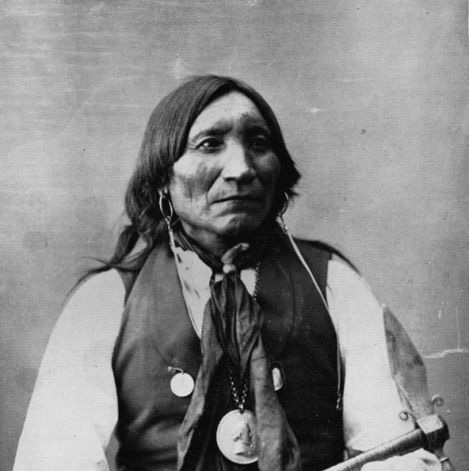
The Medicine Lodge Treaty is the overall name for three treaties signed between the United States government and southern Plains Indian tribes in October 1867, intended to “bring peace to the area” by relocating the Native Americans to reservations in Indian Territory and away from European-American settlement.
The treaty was negotiated after investigation by the Indian Peace Commission, which in its final report in 1868 concluded that the wars had been preventable. They determined that the U.S. government and its representatives, including the United States Congress, had contributed to the warfare on the Great Plains by failing to fulfill their legal obligations and failing to treat the Native Americans with honesty.
The U.S. government and tribal chiefs met at a place traditional for Native American ceremonies, at their request. The first treaty was signed October 21, 1867, with the Kiowa and Comanche tribes. The second, with the Kiowa-Apache, was signed the same day. The third treaty was signed with the Southern Cheyenne and Arapaho on October 28.
Under the Medicine Lodge Treaty, the tribes were assigned reservations of diminished size compared to territories defined in an 1865 treaty. The treaty tribes never ratified the treaty by vote of adult males, as it required. In addition, by changing allotment policy under the Dawes Act and authorizing sales under the Agreement with the Cheyenne and Arapaho (1890) and the Agreement with the Comanche, Kiowa and Apache (1892) signed with the Cherokee Commission, the Congress effectively further reduced their reservation territory.
The Kiowa chief Lone Wolf the Elder (ca.1820-1879) filed suit against the government for fraud on behalf of the tribes in Lone Wolf v. Hitchcock. In 1903 the U.S. Supreme Court ruled against the tribes, determining that the Congress had “plenary power” and the political right to make such decisions. In the aftermath of that case, Congress acted unilaterally on land decisions related to other reservations as well.
Because of the outstanding issues with the treaty and subsequent government actions, in the mid-20th century, the Kiowa, Arapaho and Comanche filed several suits for claims against the U.S. government. Over decades, they won substantial settlements of monetary compensation in the amount of tens of millions of dollars, although it took years for the cases to be resolved.
The Treaty was immediately controversial and contested by both the members and other leaders of most of the involved tribal bands. Because most of the tribes were decentralized, acceptance of the treaty was contingent upon ratification by three fourths of the adult males of each of the tribes. This condition was part of the treaty. The US never obtained sufficient votes for such ratification, and thus the treaty was never made valid or legal. Conflict over treaty terms continued for years.
The Medicine Lodge Treaty required the approval of three fourths of the adult males on the reservation for any further cessions of land. In 1887 the Congress changed national policy on allotment of Native American lands by passing the Dawes Act, which promoted allotment of parcels to individual households (they thought 160 acres per household would be adequate for cultivation) to break up the communal land held by tribes, with the government authorized to sell the resulting “surplus”.
In the case of the southern Plains Indians, a commission was assigned to gain their agreement to such allotments and sales. The 1892 Jerome Agreement, although never ratified by the tribes, implemented the new allotment policy, effectively removing millions of acres from the reservation and opening the land to white settles. The commission negotiating the agreement had evaded telling the Indians what the sale price would be. The Kiowa chief Lone Wolf sued the Secretary of the Interior on behalf of the entirety of the Kiowa, Comanche, and Apache tribes, based on their being defrauded by the government at the time.
The US Supreme Court ultimately decided the case, Lone Wolf v. Hitchcock, in 1903. In it’s ruling, the Court conceded that the Indians had not agreed to the land cessions. But, it concluded that the Congress had the “plenary power” to act unilaterally, so the circumstance did not matter.
Its decision expressed the nineteenth-century attitude toward the Native Americans. Quoting from United States v. Kagama (1855) 118 U.S.375 in it’s ruling, the court reiterated the description of the Indian tribes as “wards of the nation… Dependent largely [on the United States] for their daily food… there arises the duty of protection, and with it the power.”
Following the Supreme Court decision, the Congress continued to make unilateral changes to reservation lands without getting agreement by the tribes, beginning in 1903 and 1904 with the Rosebud Indian Reservation in South Dakota. The Commissioner of Indian Affairs, then William A. Jones, noted his intention to proceed without Native American consent. As the historian Blue Clark found, Jones wrote that he planned to report officially on land bills before Congress in favor “of Congress taking the property of Indians without their consent.” As another example, in 1907 Congress authorized the sale of “surplus” land at Rosebud, again without Indian consent.
The outstanding issues were challenged again in the mid-twentieth century, beginning in 1948. Combined Kiowa, Apache and Comanche representatives filed suit against the US government for compensation due to the original treaty and subsequent actions, including sales under the unratified Jerome Agreement. Over the following decades and through several claims, the tribes won substantial compensation of tens of millions of dollars from the Indian Claims Commission.
Photo: Lone Wolf the Elder. Wikipedia. United States public domain.










